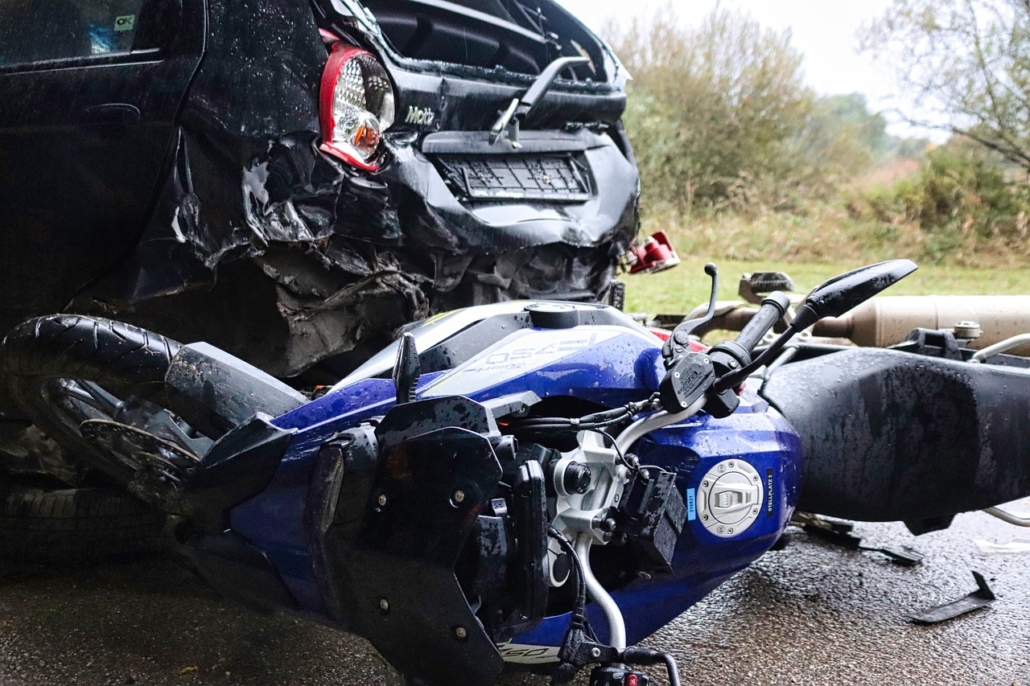Visibility issues are a major factor contributing to motorcycle accidents. Motorcycles are smaller and harder to spot compared to larger vehicles, which often leads to dangerous situations on the road. Drivers may fail to see a motorcyclist in their blind spots, during lane changes, or at intersections, resulting in collisions that can cause serious injuries. Poor lighting, weather conditions, and even road design can all exacerbate visibility problems, making it even more difficult for motorists to notice motorcycles.
Addressing visibility challenges is critical for improving motorcyclists’ road safety. By understanding the common visibility issues that lead to accidents, both drivers and motorcyclists can take proactive steps to prevent collisions and ensure a safer driving experience for everyone. Using high-visibility gear, reflective elements, and proper signaling can further reduce the risks associated with low visibility for motorcyclists.
Blind Spots: A Hidden Danger for Motorcyclists
One of the most common visibility issues faced by motorcyclists is being hidden in a vehicle’s blind spot. Larger vehicles, especially trucks and SUVs, have expansive blind spots where motorcycles can easily disappear from view. When a driver changes lanes without checking these blind spots, it can result in a serious accident involving a motorcyclist. Motorcyclists, on the other hand, must be aware of the blind spots around vehicles and avoid lingering in those areas.
Drivers should always check their mirrors and look over their shoulders before making any lane changes. Motorcyclists can also reduce their risk by staying visible and using signals to communicate their movements effectively. In addition, maintaining a safe distance from larger vehicles can help motorcyclists avoid being caught in a driver’s blind spot unexpectedly.
Low-light conditions and Nighttime Riding
Riding a motorcycle at night or in low-light conditions increases the likelihood of an accident. Drivers may have trouble seeing motorcycles when visibility is compromised, especially if the motorcycle’s headlights or reflective gear are insufficient. The risk of accidents is particularly high in poorly lit areas where streetlights are minimal, making it more difficult for other drivers to detect a motorcycle’s presence.
Motorcyclists can improve their visibility at night by wearing reflective gear and ensuring that their headlights and taillights are functioning properly. High-visibility clothing and bright accessories also make it easier for other road users to see motorcyclists in low-light conditions.
Weather Conditions that Obscure Visibility
Weather plays a significant role in motorcycle visibility. Rain, fog, or snow can obscure the view of motorcyclists, making them less visible to other drivers. Wet roads can also reduce tire traction, making it more difficult for motorcyclists to maneuver or stop quickly, especially when other drivers may not see them in time.
Both drivers and motorcyclists need to exercise extra caution in adverse weather conditions. Slowing down, increasing the following distance, and using proper lighting can help reduce the risk of accidents. For motorcyclists involved in such collisions, a Denver motorcycle accident lawsuit may be necessary to recover compensation for any injuries sustained.
Glare from the Sun or Headlights
Glare from the sun during the early morning or late afternoon can make it harder for drivers to see motorcycles on the road. Similarly, the glare from oncoming headlights at night can cause temporary blindness, making it difficult for drivers to notice smaller vehicles like motorcycles. Glare reduces a driver’s ability to react quickly, which can result in accidents, especially in high-traffic areas.
Motorcyclists can mitigate the risks of glare by adjusting their position on the road and using anti-glare visors or glasses. Drivers should also take precautions by using their sun visors and keeping their windshields clean to reduce the impact of glare.
Intersections: High-Risk Areas for Visibility Issues
Intersections are another high-risk area for motorcyclists due to visibility issues. Drivers may fail to notice a motorcycle when making turns or pulling out from a stop sign, particularly if the motorcycle is coming from a direction that’s hard to see. This lack of visibility often leads to accidents where the motorcyclist is struck by a turning vehicle or is forced to swerve to avoid a collision.
To stay safe at intersections, motorcyclists should approach cautiously and make themselves as visible as possible by using their headlights and signals. Drivers must also take the time to look carefully in all directions, especially for smaller vehicles like motorcycles that may be harder to spot.
The Impact of Road Design on Visibility
Poor road design can contribute to visibility issues for motorcyclists. Roads with sharp curves, blind turns, or obstructed views make it more difficult for drivers to see oncoming motorcycles. In areas with poor signage or lighting, the risk of accidents increases, as both drivers and motorcyclists may have less time to react to each other’s presence.
Municipalities and road designers can improve visibility by ensuring that roads are well-marked, adequately lit, and free from obstructions that block a driver’s view of oncoming traffic. Until then, motorcyclists should exercise caution when navigating unfamiliar or poorly designed roads.
Distracted Driving and Its Effect on Motorcycle Visibility
Distracted driving is a growing issue that significantly affects motorcycle visibility on the road. When drivers are distracted by their phones, GPS, or other in-vehicle technologies, they are less likely to notice motorcyclists, especially in high-traffic areas or at intersections. Even a momentary lapse in attention can lead to serious collisions, as motorcycles are smaller and easier to overlook than larger vehicles.
Motorcyclists must be aware of the risks posed by distracted drivers and take defensive measures to stay visible, such as wearing bright clothing and maintaining a safe distance from other vehicles. Drivers should also eliminate distractions and remain focused on the road to avoid missing the presence of nearby motorcyclists.
The Importance of Motorcycle Awareness Campaigns
Motorcycle awareness campaigns play an essential role in educating drivers about the visibility challenges motorcyclists face. These campaigns encourage drivers to check their blind spots, be extra vigilant in low-light or poor weather conditions, and give motorcyclists more space on the road. Public awareness efforts help reduce accidents by promoting safe driving habits that consider the vulnerabilities of motorcyclists.
By raising awareness about the visibility issues that motorcyclists encounter, these campaigns contribute to a safer driving environment for everyone on the road. In addition, they can help foster a sense of shared responsibility among all road users, encouraging both drivers and motorcyclists to prioritize safety and remain attentive while driving.



